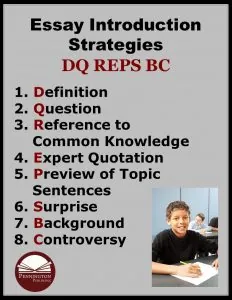
I hate introductions.
I know; that first sentence is an introduction. It’s probably inevitable, since every essay has to start somewhere.
And, as an introduction, it does what it should. It says what the post is about (a critique of introductions), sets the tone (a little snark, in keeping with a blog named ohick.com), and maybe even “hooks” the reader (in part through the snark, in part through shared experience among writers and readers).
So, I guess, the problem isn’t really with introductions, per se. The problem is that I’ve just finished grading a set essays from students who rely way too much on formulas they’ve learned.

I get formulas. It’s hard for beginning writers to internalize abstract principles, and formulas give a framework within which to apply those principles, to learn how they work. Unfortunately, too many students (and others) lose track of the purpose of the formulas. They accept a simple list of possible strategies that they assume will automatically generate a good introduction.
And that’s precisely the problem: this assumption that any of these strategies will work, no matter what the context, and no matter what the content, is wrong.
Of course, no teacher tells students that these strategies can be applied mindlessly. I’m not even sure that students consciously believe that. But in practice, far too many of them treat these strategies one of two ways: they either choose one and use it for every damn essay, or they select one apparently at random and run with it.
So, for example, I’ve had students who begin every essay with a single word or phrase:
Computers. Sometimes they help us, and sometimes they hurt us.
or
Music. Some say it can soothe the savage beast.
Others prefer—always—to start with a question:
Have you ever wondered what it would be like to be a pregnant teenager in the Middle Ages? [Erm… can’t say I have. And since the concept of a “teenager” didn’t really show up until the 20th century, I couldn’t really wonder this, even if I wanted to.]
or
Have you ever thought about subcultures and the different types of subcultures?

And then there are the students who will shoehorn any topic into a “general-to-specific” pattern. It’s not that there’s anything inherently wrong with that pattern; done right, it gives readers context, helping us understand that the essay’s specific topic (student athletes at the writer’s college, say) is significant because it’s part of a larger issue (exploitation of student athletes across the state).
But here’s the type of thing that I get (and I am quoting this word for word; it’s not made-up or exaggerated):
Ever since humans and animals have walked the face of the earth, humans have used animals to test cosmetics.

If the problem were only with my students, I wouldn’t be so annoyed by all this. For an English teacher, bad introductions are an occupational hazard, and I do at least have the chance to encourage them to move beyond the formulas.
But bloggers. My god.
I’ve admitted, however reluctantly, that introductions do fulfill several useful functions, including “hooking” the reader—making her want to keep reading.
But some posts don’t need hooks. If I’ve searched for a recipe for Jambalaya, there’s no need to keep me reading. I’ll either like the recipe, or I won’t, and no “expert quotation” from Mark Twain about how delicious New Orleans food is will change my mind.
Or if I’ve searched for instructions to factory reset my Samsung Galaxy S7, then it’s obvious that I don’t know how. So why ask?
Or if I’ve landed on an article whose title tells me I will learn different ways to organize Evernote, do I need a metaphor about Fords and Ferraris?
Deep breath…
Formulas, templates, frameworks, strategies—none of these comes with guarantees. Choose wisely. Context matters. Content matters. Purpose matters.
In conclusion… (just kidding… we can save this pet peeve for another day…)
Leave a Reply